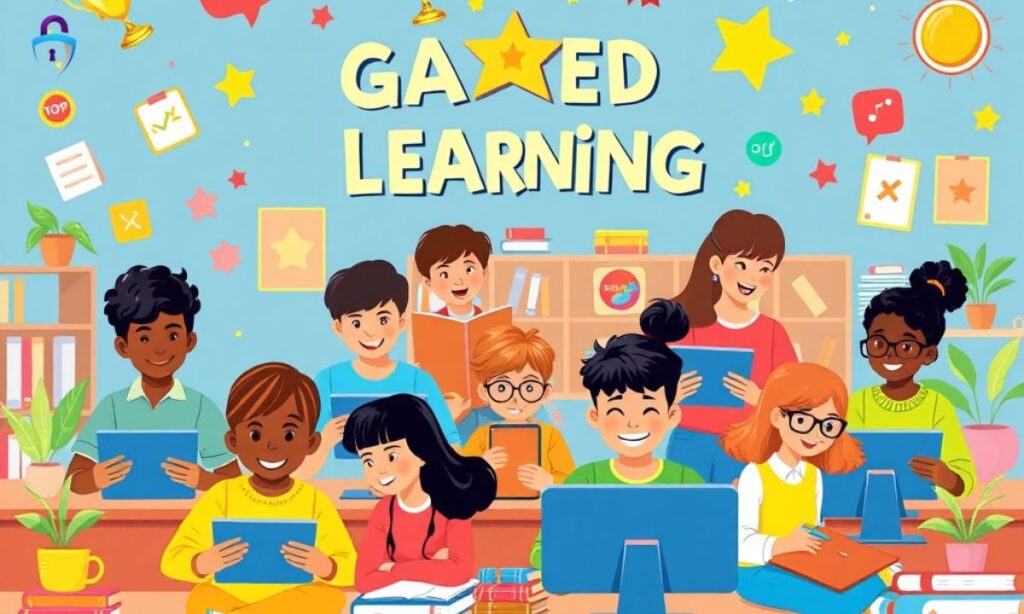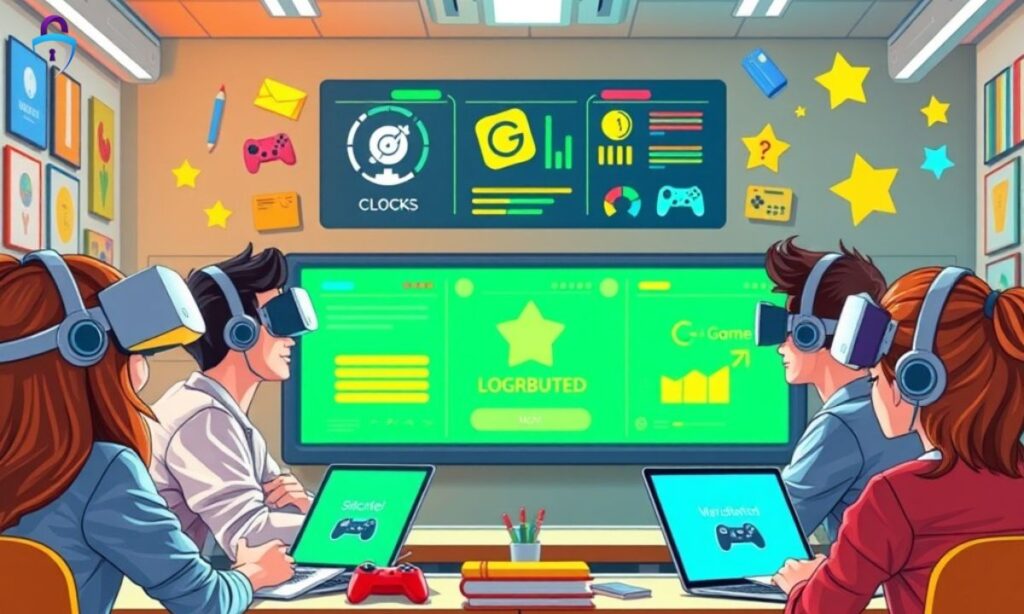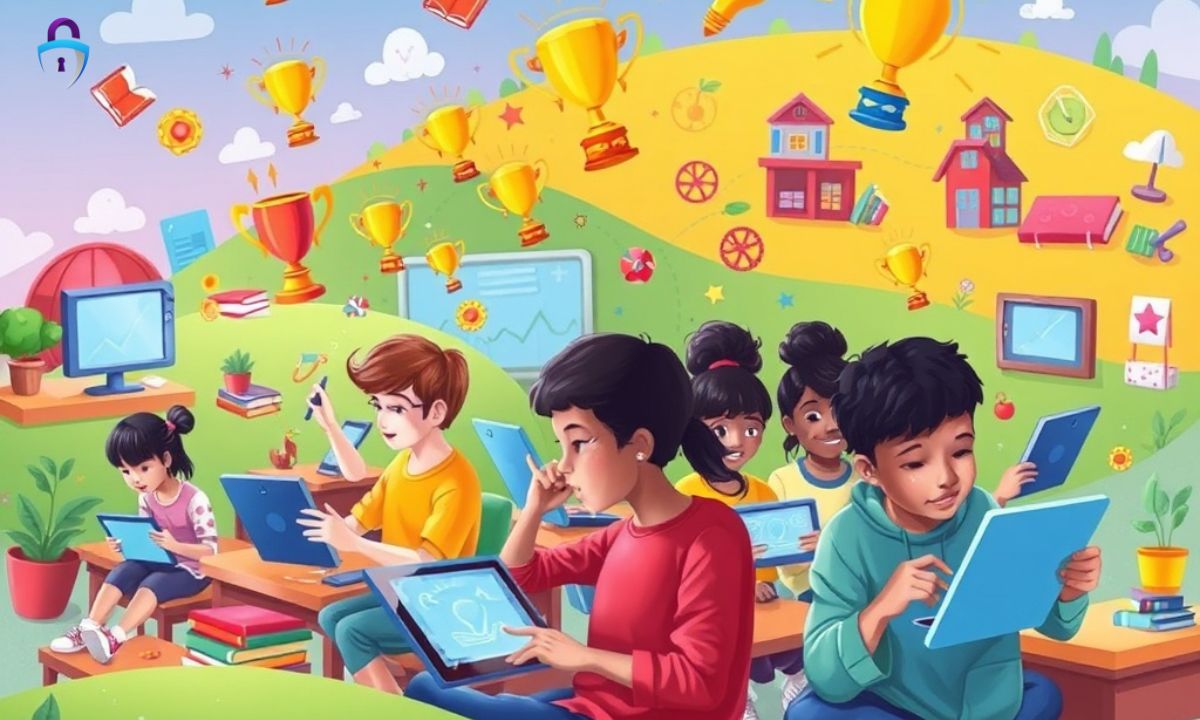Learning is changing with the help of online games. Many teachers now use games to make learning fun. This is called gamification. It helps students stay focused and enjoy their lessons.
Games can teach math, reading, and even science. Students feel excited when they earn points or badges. This way, they learn without feeling bored. Gamification makes learning fun and easier for everyone.
🚀 Creative Name Generator
Group Names
Sports Teams
Game Names
School Names
Business Names
Fantasy Teams
Select a category to generate names
Understanding Gamification in Education 🎓
- Level up learning through gamification! 🎮
- Learning + fun = gamification magic ✨
- Game mechanics in the classroom? Yes! 🏆
- Turning lessons into games 🎯
- Learning by playing 🧠
- Points, badges, progress—gamified! 🏅
- Gamifying study time 📘➡️🎮
- Play your way to knowledge 🎓
- Lessons with levels 🚀
- Quest-based learning is real 👾
- Motivation through game design 💡
- When learning becomes a game 🎉
- Badge-earned learning ✅
- Score points for knowledge 📊
- Classroom meets video game 🎲
- Study rewards for doing your best 🏅
- Challenges equal growth 🎯
- Learning with feedback loops 🔄
- Education meets gamification 🧠+🎮
- Progress bars in learning 📈
- From boring to engaging with gamified learning 🎉
- Gamification fuels motivation 🔥
- Study like you’re playing a game 🎯
- Earning points while learning 🧩
- Game thinking in education 🕹️
- Interactive learning with missions 🎮
- The power of game-based teaching 🏫
- Smash quizzes like boss fights ⚔️
- Engage with leaderboard-style learning 🌟
- Level-based progression for lessons 📚
- Rewards make learning addictive 🎁
- Learning mechanics inspired by games 🧠
- Gamified tasks = learning fun ✔️
- Learning missions unlock knowledge 🔓
- Turn assignments into quests 🗺️
- Virtual progress fuels real learning 🚀
- Quest your way through concepts 📘
- Game dynamics support retention 🧠
- Badge your progress 🏅
- Real-world skill through game-based teaching 🛠️
- Win points, learn concepts 📚
- Next level: education 🎓➡️🚀
- Reward systems in education 🎁
- Gamification brings active learning ⚡
- Friendly competition in class 🏁
- Gamified study zones 📘🎮
- Engaging lessons in game form 🎯
- Score high by learning smart 🧠
- Leaderboards for academic success 🏆
- Unlock knowledge like trophies
The Rise of Online Educational Games 🌐
- Learning goes online and fun 🕹️
- Game-based education on your screen 💻
- Canvas becomes a virtual playfield 🎮
- Rise of online learning games 🚀
- Virtual quizzes with instant feedback 💡
- Online games teaching math, reading & more 📚
- Education moves to the digital playground 🌍
- Interactive games for remote learners 🏠
- Online adventures in learning 🎯
- Teachers turning digital games into lessons 🧑🏫
- Play, learn, repeat—online! 🔄
- Virtual rewards, real success 🏅
- Cloud-powered educational games ☁️
- Learn in worlds made for play 🌌
- Short, fun online learning modules ⏱️
- Videos + games = powerful combo 🎥+🎮
- Digital badges for remote learning 📲
- Gamified learning with zero commute 🚌
- Real-time game feedback online 🕒
- Connect, play, learn together 🌐
- Study games at home? Totally possible ☕
- Online quizzes that feel like games 🧩
- Learning shaped by pixels 🎨
- Virtual classrooms that resemble games 🖥️
- Scholarships through game-based tests 🎓
- Collaborative online educational games 👥
- Multiplayer learning sessions ✅
- Digital quests that teach and engage 🔎
- Dashboards for game-based progress 📊
- School from screen to game zone 🎮
- E‑learning gamified with fun designs 🎨
- Transforming remote learning with games 🏠
- Edtech + gaming = online magic ✨
- Gamified simulations in virtual classrooms 🧩
- From textbooks to game interfaces 📘➡️🕹️
- Learning suffers? Then try an educational game 👊
- Cloud classrooms powered by game logic ☁️
- Short, bite‑sized game-based lessons ⏳
- Teacher‑built online learning games 🧑🏫
- Affordable edu‑games online 💸
- Lessons via game worlds 🎮
- Citizen science through online games 🌍
- Self‑paced learning with online games ⏬
- Global classrooms powered by play 🌐
- Virtual flashcards with game mechanics 🎴
- Animations + gameplay = better retention 🎥🕹️
- Remote learning made fun 💡
- Students thrive in online gaming classrooms 🌟
- Real learning through digital play ✅
- Web‑based learning adventures await 🌐
Benefits of Gamified Learning for Students 🎯

- Gamified learning boosts motivation 📈
- Students stay engaged longer 🔥
- Reward systems encourage progress 🎁
- Fun quizzes improve retention 🧠
- Learning feels like play, not work 🎮
- Instant feedback boosts performance 🕒
- Progress tracking builds confidence 🌟
- Collaboration through team‑based games 🤝
- Friendly competition sparks effort 🏁
- Critical thinking through game challenges 🤔
- Better focus with interactive design 🎯
- Goal-setting taught through levels 🎮
- Confidence grows with each badge earned 🏅
- Memory sticks with game‑style learning 🧠
- Self‑paced pace reduces stress 😌
- Encourages problem‑solving skills 🛠️
- Motivation via gamified streaks 🔄
- Real‑time scores for self awareness 📊
- Fun content improves attendance 📚
- Game rewards reinforce good habits ✅
- Students feel ownership of learning 🏠
- Virtual challenges unlock skills 🗝️
- Saves time with efficient games ⏱️
- Diverse learning styles supported 🎨
- Enhances teamwork and social skills 🧑🤝🧑
- Positive feedback encourages effort 🌈
- Builds resilience through game retries 🔄
- Real-world concept practice inside games 🏗️
- Curiosity increases with game puzzles ❓
- Boosts digital literacy alongside lessons 💻
- Safe environment for making mistakes 🛡️
- Real-time progress visualization 📈
- Adventure-style learning keeps interest 🎒
- Students learn through experience 🧩
- Achieve mastery with adaptive game levels 📚
- Encouraging discovery through game play 🔍
- Improves cognitive flexibility 🧠
- Better test performance from fun practice 🎓
- Learning goals turned into missions 🎯
- Fosters growth mindset with retries 💡
- Helps with attention and focus ⚡
- Reduces boredom in the classroom 💤
- Builds digital collaboration skills 🖥️
- Prepares students for future tech 🌐
- Adaptable for different learning needs ♾️
- Instant rewards for achievements 🎉
- Gamified journals track progress 📘
- Encourages critical thinking puzzles 🧠
- Creative expression through game design 🎨
- Plays into playful curiosity for better learning 🌟
Key Elements That Make Learning Games Effective ⚙️
- Clear goals with missions 🎯
- Immediate feedback for learners ⚡
- Meaningful rewards keep students motivated 🏅
- Progress tracking through levels 📊
- Challenges that scale with skills 📈
- Rewards, points, badges system 🧩
- Leaderboards with friendly competition 🥇
- Storytelling to engage students 📖
- Choice and personalization in play 🎨
- Visual progress bars and trackers ⏳
- Quests that teach concepts 🌍
- Mini games for focused learning 🕹️
- Adaptive difficulty to meet needs 🎮
- Clear instructions & support 🗺️
- Collaboration features for teamwork 🤝
- Real‑world context in game challenges 🏙️
- Feedback loops for reinforcement 🔁
- Unlockable bonuses and achievements 🔓
- Checkpoints to measure learning ✅
- Narrative arcs to guide gameplay 🧠
- Fun animations tied to progress 🎥
- Interactive puzzles for concept mastery 🧩
- Custom avatars for identity and motivation 🎨
- Rewards aligned with learning goals 🏅
- Practice through varied scenarios 🧠
- Time‑limited challenges for urgency ⏱️
- In‑game economies for decision‑making 💰
- Social features like sharing achievements 🌐
- Reflection prompts after each level 💭
- Reinforcement through repetition 🔂
- Visual and audio cues to support learning 🔊
- Player autonomy in quest selection 🛤️
- Story-based problem solving 📝
- Goal scaffolding from easy to hard 🏗️
- Rewards tied to effort and growth 🌱
- Analytics to track student progress 📊
- Celebration animations for achievements 🎉
- Puzzle-based learning tasks 🧠
- Cooperative missions for group learning 👥
- Integration of real-world data 🌍
- Skill-building with progression systems 🏗️
- Accessibility features for all learners ♿
- Meaningful choice in gameplay 🎮
- Reward diversity: points, badges, titles 🏅
- Feedback that encourages improvement 💡
- Storylines that make concepts memorable 📚
- Challenge-based levels to reinforce skills 🎯
- Visual growth bars for motivation 📈
- Peer competition via leaderboards 🏆
- Exit surveys or reflections built-in 💬
Case Studies: Success Stories of Gamification in Schools 🏫
- Students leveled up their grades through game‑based learning! 🌟
- Classroom heroes emerging thanks to gamification awards 🏆
- Real schools seeing real results—gamification works! ✔️
- One school turned math into a quest—and aced it 🧮✨
- Literacy goals met via a reading badge system 📚✅
- Science class got competitive—and test scores soared 🥼🚀
- Attendance improved when learning felt like play 🏫🎮
- Schools aren’t just buildings—they’re game zones now 🕹️
- Teachers report better focus with gamified lessons 🔍
- Homework became mission-based—and fun 🎯
- Reading streaks earn badges and boost engagement 🏅
- One school’s math leaderboard inspired friendly rivalry 📊
- Gamification brought teamwork to STEM labs 🧪🤝
- Students unlocked projects with earned points 🔓
- A language class turned into a quest for fluency 🌐
- One gamified history class became a time‑travel game ⏳
- Game-based quizzes improved recall rates by 30% 🧠📈
- Teachers use game tokens for in-class rewards 🎟️
- A school gamified attendance—and saw improvement 🗓️🌟
- Students earning levels in geography—world domination style! 🌍
- Classroom missions lead to collaborative wins 🤖
- Earning badges made shy students shine 🏅
- Schools mixing games and learning—and it’s working 🎲
- Students mastering topics one level at a time 🔝
- Teachers witnessed higher motivation with missions 🏹
- Quiz battles brought engagement to classrooms ⚔️
- A principal reported happier students post‑gamification 🎉
- Languages learned via interactive story games 📖
- Computer clubs tested new gamified learning apps 📱
- Schools boosting creativity through game design projects 🎨
- A gamified art class unlocked student excitement 🎨
- Peer‑led game challenges encourage collaboration 🧑🤝🧑
- Students earn levels instead of just grades 🎮
- Teachers share success stats from gamified classrooms 📊
- Homework rewards turned into mini‑quests 📜
- Students stay on task when there’s a leaderboard! 🏁
- Gamified spelling bees make learning words fun 🐝
- Teachers report better behavior with game incentives 🎮
- A class created their own educational game—crowd favorite! 🕹️
- Personalized quests helped struggling learners progress 🌈
- Teachers say gamification increased class participation 👥
- Students remember concepts better with game‑style review 🧠
- Gamified test prep beats traditional drills any day 📝
- Classroom missions fostered peer mentoring 🤝
- Schools use game progress as parent‑teacher talking points 📈
- Gamification brought silent students into the spotlight 🎤
- Quest-style units made history lessons unforgettable 🏛️
- STEM games sparked coding interest across the grade 🔧
- Gamified attendance prompted consistent classroom presence 🗓️
- A school-wide game competition boosted school spirit 🌐
Challenges and Limitations of Learning Through Games 🚧
- Not all students engage with game-based learning 🤷
- Lack of access to tech limits gamification impact 💻✋
- Over-gamification can distract from learning goals 🚧
- Poorly designed games may confuse rather than teach 🆘
- Not every subject suits a game-based approach 📘
- Teacher training gaps hinder gamification success 👩🏫
- Budget constraints block access to quality edu‑games 💸
- Small classes may limit competitive game play 👥
- Balancing fun with learning can be tricky ⚖️
- Students may focus on rewards—not knowledge 🤔
- Gaming fatigue can reduce engagement over time ⏱️
- Too much screen time raises health concerns 🖥️🛌
- Data privacy risks come with online tools 🔒
- Games may reinforce low‑effort habits if too easy 💤
- Poor feedback can demotivate students 🌧️
- A one-size-fits-all game doesn’t fit all learners ✂️
- Technical glitches disrupt learning flow 🖥️⚙️
- Costs of subscriptions can outweigh benefits 💳
- Admin support essential—or initiatives fail 🏢
- Game-based learning needs curriculum alignment 📜
- Overemphasis on points distracts from learning goals 🧩
- Some students may feel embarrassed in competitive games 😳
- Screen glare hinders visibility in some classes 📱🔆
- Access inequity widens achievement gaps ⚖️
- Teachers may lack time to develop gamified lessons ⏰
- Game complexity may overwhelm younger learners 🌱
- Cultural differences in games can alienate students 🌍
- Excessive digital play may affect social skills 🎭
- Overly simplistic games bore advanced students 💤
- Gamification setups can be resource-heavy 🏗️
- Poor implementation yields limited results ⬇️
- Students may cheat leaderboards for easy points 🕵️
- Game failure can demoralize some students 💔
- Hardware issues can halt play abruptly ⚠️
- Not all platforms are age-appropriate—watch content! 🚨
- Insufficient teacher buy-in can derail success 😕
- Lack of varied rewards may reduce game appeal 🏅
- Reliance on flashy visuals may overshadow content 🎨
- Games often focus on right/wrong—not deep thinking 🤯
- Poor UX frustrates students quickly 😡
- Not all assessments translate to game formats 📊
- Social barriers limit multiplayer game usefulness 👥
- Game-based learning may lack long-term impact studies 📚
- Budget cuts can cancel gamified programs mid‑year 💔
- Students may view games as entertainment only 🆗
- Time to prep gamified lessons adds teacher load ⏳
- Tech issues can steal valuable class time ⏰
- Overreliance on games can reduce diverse teaching methods 📉
- Assessment may skew towards gaming success, not comprehension 📋
- Difficulty tracking individual growth in group games 👀
Future Trends in Educational Gamification 🔮

- Virtual reality field trips raise learning to new levels 🕶️
- AI tutors level up by adapting in real time 🤖
- Augmented reality challenges bring lessons to life 📱
- Blockchain badges become permanent digital trophies ⛓️
- Personalized quests crafted by smart algorithms 🧠
- Haptic feedback brings game worlds into classrooms 🤚
- Mixed reality labs make science hands-on, virtually ✨
- Game-based learning via voice assistants 🚀
- AI-driven leaderboards for fair competition 🏅
- VR history tours immerse students in time travel ⏳
- Smart puzzles that evolve as students grow 🔄
- Sonic learning—sound-based gamification 🎶
- Wearables track and reward physical learning activities ⌚
- Learning via educational e‑sports tournaments 🏆
- AR overlays teach anatomy on real labs 🩻
- Classroom NPCs (non-player characters) as digital tutors 🧑🏫
- Adaptive storylines shaped by student decisions 📖
- Micro‑learning games for short bursts of learning ⏱️
- Global classroom quests unite students worldwide 🌏
- Gamified coding with robo‑trainers 🤖
- Virtual reward economies teach financial literacy 💰
- AI feedback systems that grade like games 📝
- Smart badges linked to student portfolios 📂
- Immersive game worlds aligned with school curricula 🌍
- Game‑based assessments graded by AI 🧮
- VR safety training simulations for future careers 🦺
- 3D‑printed game objects for tactile learning 📐
- Holographic tutors guide lessons hands‑free 🌟
- AI‑powered game journaling and reflection tools 📓
- Sensor‑based games that blend physical and digital 🕹️➡️🏃
- Collaborative VR projects across classrooms 🧑🤝🧑
- Voice‑activated learning puzzles and games 🎙️
- Mixed‑reality lab simulations in science classes 🧪
- IoT‑enabled game worlds in the classroom 🌐
- Gamified language translation for global learners 🌎
- Emotion‑aware games that adapt to student mood 😊
- Real‑world missions powered by educational games 🗺️
- AI‑designed game levels for optimal challenge 🏗️
- Immersive storytelling via AR field guides 📘
- Gamified peer review systems in project-based learning 👥
- Brain‑computer interfaces for thought‑driven games 🧠
- Smart badges shareable across education platforms 📲
- Dynamic group quests based on real‑time data ℹ️
- Gamified soft skills training through virtual sims 🧑💼
- Sustainable learning games promoting environmental awareness 🌱
- AI‑driven faction‑based classroom games 🏰
- Mixed‑reality sandboxes for creative problem solving 🏖️
- Geo‑gamified history via location‑based play 🗺️
- Personalized game trophies as digital diplomas 🎓
- Machine‑learning powered game analytics for teachers 📈
How Educators Can Integrate Games into the Classroom 🧑🏫
- Start small—add a mini‑quiz game once a week 🎲
- Create simple missions for homework tasks 📝
- Use free edu‑games available online 💻
- Turn review sessions into friendly competitions 🚩
- Try leaderboard challenges for vocabulary words 🏆
- Award custom badges for progress and effort 🏅
- Use quiz apps with instant feedback ⏱️
- Gamify daily tasks with token rewards 🎟️
- Design a “quest board” on the classroom wall 🗺️
- Let students vote on which games to play 🗳️
- Pair students for co-op gameplay learning 🤝
- Align game tasks with learning objectives 📘
- Use game breaks as fun motivation boosts 🎮
- Flip roles—students create classroom games 👾
- Include reflection prompts after each game 💭
- Rotate “game master” each week to lead play 🎩
- Link game scores to real-world outcomes (e.g., choice of activity) 🏅
- Celebrate wins with small classroom ceremonies 🎉
- Use story-based games to teach narratives 📖
- Invite students to help design badges 🖌️
- Gamify group discussions with timer challenges ⏳
- Create classroom quests with subject-specific themes 🌍
- Use game design tools (like Scratch) in class ✂️
- Introduce challenges as “missions” rather than tasks 🎯
- Connect games to real-life applications 🛠️
- Host a mini‑tournament for math or spelling bees 🐝
- Share student progress on a public leaderboard 📊
- Let students pick their learning “avatars” 🎭
- Add surprise bonus rounds after lessons 😉
- Invite parents to view gamified portfolios 📂
- Track class progress with visual charts 🌈
- Use audio‑visual cues to gamify transitions 🎶
- Group students to tackle learning quests collaboratively 🏗️
- Use digital badges connected to parent apps 📱
- Gamify vocabulary with flashcard battles 🥊
- Use platform analytics to tailor game difficulty 📈
- Reflect on learning post‑game with class discussion 🗣️
- Incorporate mini games into lesson segments ⏸️
- Start each lesson with a gamified warm‑up 🔥
- Let students create their own classroom mini‑games 🕹️
- Use storytelling as a game mechanic in lessons 📚
- Reward effort as well as correct answers 🌟
- Use game templates from teacher communities 🖥️
- Add fun badges for teamwork and kindness 🤝
- Let students “level up” within subjects 📈
- Use point systems to spur positive behavior 🌈
- Collect feedback to refine gamified lessons 📋
- Rotate game roles (scorekeeper, timekeeper) weekly ⏲️
- Blend physical and digital tasks in learning games 🎮🏃
- Encourage peer-created missions—they know what works! 🧑🤝🧑
Frequently Asked Questions
What is gamification in education?
Gamification is the use of game elements like points, levels, and badges to make learning more engaging.
How does gamified learning help students?
It increases motivation, improves focus, and makes learning more interactive and enjoyable.
Are educational games suitable for all ages?
Yes, games can be tailored for different age groups and learning levels.
Do teachers need special training to use gamification?
Basic training or familiarity with digital tools can help teachers apply gamification effectively.
Can gamification replace traditional teaching?
No, it should be used as a supportive method alongside traditional teaching techniques.
Conclusion
Gamification in education is transforming how students engage with learning. By turning lessons into interactive experiences, students become more motivated, focused, and eager to participate in class activities. It blends fun with knowledge, making education feel less like a task and more like an adventure.
While there are challenges, such as ensuring equal access to technology and balancing fun with educational value, the benefits are clear. With thoughtful implementation, gamification can enhance classroom experiences, improve academic outcomes, and prepare students for a more dynamic future in learning.

James Anderson expert at GoNamePro, crafting unique group, sports, game, and school names to inspire creativity and identity.






